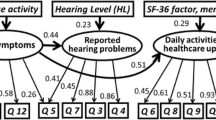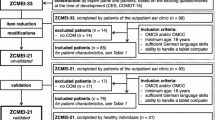Abstract
The Dutch translation of the OM8-30 questionnaire, originally developed in the UK on a large clinical sample, has been applied for validation in an ENT sample, with the aim of assessing otitis media impact and identifying treatment needs in children suffering from chronic otitis media (OM) and/or upper respiratory tract infections (URTI). Caregivers of 246 children completed the OM8-30 and also the generic Strengths and Difficulties Questionnaire (SDQ), prior to otolaryngologist consultation. Factor analysis confirmed the hypothesized six-factor structure, accounting for 55.5% of the variance. The internal consistency was satisfactory to good for all of the physical and developmental facets (α-values ≥ 0.68). The correlation matrix with the SDQ scales and total difficulties score showed significant relationships for almost all of the OM8-30 developmental facets and sub-aggregate (Ps < 0.01), supporting the concurrent validity of the OM8-30 as a measure of impact in otitis media. This first examination of the Dutch OM8-30 shows that the psychometric characteristics are sufficiently good for the assessment of disease impact, and that this can be subdivided into impact on physical health and on developmental aspects. Recommendations for further research include the study of confounders such as hearing, age and previous operations so that these can be adjusted out, and the determination of which subgroup of children may benefit from tympanostomy tubes.
Similar content being viewed by others
References
Rosenfeld RM, Kay D (2003) Natural history of untreated otitis media. Laryngoscope 113:1645–1657
Paradise JL, Feldman HM, Campbell TF, Dollaghan CA, Colborn DK, Bernard BS (2001) Effect of early or delayed insertion of tympanostomy tubes for persistent otitis media on developmental outcomes at the age of three years. New Engl J Med 344:1179–1187
Rovers MM, Black N, Browning GG, Maw R, Zielhuis GA, Haggard MP (2005) Grommets in otitis media with effusion: an individual patient data meta-analysis. Arch Dis Child 90:480–485
van de Lisdonk EH, van Balen FAM, van Weert HCPM, Eekhof JAH, Appelman CLM, Eizenga WH (2000) Dutch college of general practitioners-practice guideline Otitis media with effusion. Huisarts en Wetenschap 43:171–177
Rosenfeld RM, Culpepper L, Doyle KJ, Grundfast KM, Hoberman A, Kenna MA et al (2004) Clinical practice guideline: otitis media with effusion. Otolaryngol Head Neck Surg 130:S95–S118
Ruben RJ (2003) Host susceptibility to sequelae. In: Rosenfeld RM, Bluestone CD (eds) Evidence-based otitis media. 2nd edn. BC Decker Inc., Hamilton, pp 505–514
Haggard MP, Smith SC, Nicholls EE (2003) Quality of life and child behaviour. In: Rosenfeld RM, Bluestone CD (eds) Evidence-based otitis media, 2nd edn. BC Decker Inc., Hamilton, pp 401–429
Anteunis LJC, Engel JAM (2000) Maastricht otitis media with effusion study (dissertation). Maastricht University, Maastricht
Morris PSL, Leach AJ (2003) Is early surgical referral for children with persistent otitis media with effusion (OME) appropriate? Med J Aust 179:436–437
van Widenfelt BM, Goedhart AW, Treffers PDA, Goodman R (2003) Dutch version of the Strengths and Difficulties Questionnaire (SDQ). Eur Child Adolesc Psychiatry 12:281–289
Haggard M, Nicholls E, Gregori M, Spencer H, Francois M, Pitkaranta A et al. (2005) Internationally comparable measures of impact in children with OME—the Eurotitis project to standardise OM8–30. In: XVIII IFOS congress, Rome, 25–30 June 2005
Haggard M, Spencer H, Gregori M (2007) Internationally standardised clinical description: can it be achieved in ENT? ENT News 16:69–72
Haggard M, Spencer H, Gregori M (2007) Overcoming international differences for clinical comparisons and research. ENT News 16:68–71
Muris P, Meesters C, van den Berg F (2003) The Strengths and Difficulties Questionnaire (SDQ). Further evidence for its reliability and validity in a community sample of Dutch children and adolescents. Eur Child Adolesc Psychiatry 12:1–8
Goodman R (1997) The strengths and difficulties questionnaire: a research note. J Child Psychol Psychiatry 38:581–586
Goodman R (2001) Psychometric properties of the Strengths and Difficulties Questionnaire. J Am Acad Child Adolesc Psychiatry 40:1337–1345
Klasen H, Woerner W, Wolke D, Meyer R, Overmeyer S, Kaschnitz W et al (2000) Comparing the German version of the Strengths and Difficulties Questionnaire (SDQ-Deu) and the Child Behaviour Checklist. Eur Child Adolesc Psychiatry 9:271–276
Alho OP, Oja H, Koivu M, Sorri M (1995) Chronic otitis media with effusion in infancy. How frequent is it? How does it develop? Arch Otolaryngol Head Neck Surg 121:432–437
Kubba H, Pearson JP, Birchall JP (2000) The aetiology of otitis media with effusion: a review. Clin Otolaryngol 25:181–194
West JV (2002) Acute upper airway infections. Br Med Bull 61:215–230
Bennet KE, Haggard MP (1998) Accumulation of factors influencing children’s middle ear disease: risk factor modelling on a large population cohort. J Epidemiol Comm Health 52:786–793
Brouwer CNM, Maille AR, Rovers MM, Grobbee DE, Sanders EAM, Schilder AGM (2005) Health-related quality of life in children with otitis media. Int J Pediatr Otorhinolaryngol 69:1031–1041
Timmerman AA, Anteunis LJC, Meesters CMG (1999) The initial development of an instrument for the description of ‘Otitis Media with Effusion Specific Behaviour’ in young children. Int J Behav Med 6:255–267
Eiser C, Morse R (2001) Can parents rate their child’s health-related quality of life? Results of a systematic review. Qual Life Res 10:347–357
Brouwer CNM (2003) Health-related quality of life in children with recurrent acute otitis media (dissertation). Utrecht University, Utrecht
Boomsma LJ, van Balen FAM, Rovers MM, Wiersma T, Goudswaard AN (2006) Summary of the practice guideline ‘Otitis media with effusion’ (second revision) from the Dutch College of General Practitioners. Nederlands Tijdschrift voor Geneeskunde 150:2028–2032
Rovers MM, Schilder AGM, Zielhuis GA, Rosenfeld RM (2004) Otitis media. Lancet 363:465–473
Engel JAM, Anteunis LJC (1999) Treatment with ventilation tubes in the Netherlands: incidence in children from birth to 12 years of age, 1990–1994. Nederlands Tijdschrift voor Geneeskunde 143:902–905
Lous J (1995) Otitis media and reading achievement: a review. Int J Pediatr Otorhinolaryngol 32:105–121
Acknowledgments
This study was supported by the Heinsius Houbolt Foundation and the ENT Research Foundation of the University Hospital of Maastricht, the Netherlands. Elaine Nicholls and Helen Spencer from the MRC Multi-centre Otitis Media Study Group at Cambridge (UK), are appreciated for their assistance in the preparation of this paper. The Dutch OM8-30 can be downloaded from: http://www.azm.nl/5008/11862/5021/Vragenlijst_kind_vocht_acht1.pdf and the Dutch SDQ from: http://www.sdqinfo.com
Author information
Authors and Affiliations
Corresponding author
Rights and permissions
About this article
Cite this article
Timmerman, A.A., Meesters, C.M.G., Anteunis, L.J.C. et al. Psychometric evaluation of the OM8-30 questionnaire in Dutch children with otitis media. Eur Arch Otorhinolaryngol 265, 1047–1056 (2008). https://doi.org/10.1007/s00405-008-0591-2
Received:
Accepted:
Published:
Issue Date:
DOI: https://doi.org/10.1007/s00405-008-0591-2




